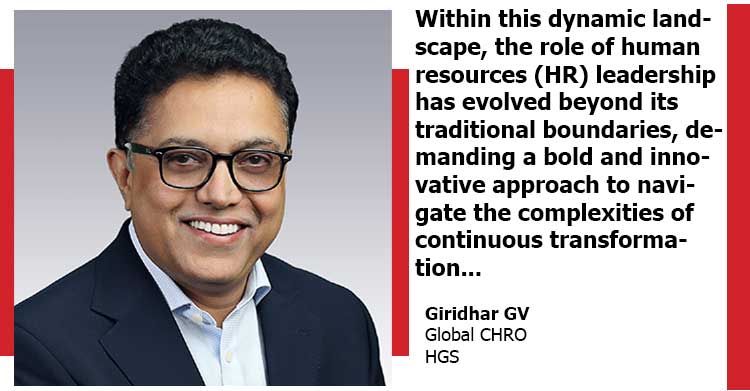Bold HR Leadership in the Age of Continuous Transformation: Navigating the Digital Frontier | Giridhar GV | Global CHRO | HGS

In an era defined by perpetual change, the digital age is ushering in unprecedented transformations, shaping the way organizations operate and thrive. Within this dynamic landscape, the role of human resources (HR) leadership has evolved beyond its traditional boundaries, demanding a bold and innovative approach to navigate the complexities of continuous transformation.
Digital transformation is more than just a buzzword; it is a fundamental shift in how businesses operate. In this context, HR leaders find themselves at the forefront of steering organizations toward success in an era marked by technological advancements and rapid digitalization.
Digital Technologies Reshaping the Workplace: Riding the Technological Wave
The workplace is undergoing a profound revolution fueled by the integration of digital technologies such as artificial intelligence (AI), machine learning, and automation. HR leaders are not only tasked with embracing these technologies but also with understanding their implications on workforce dynamics. Automation, for instance, streamlines repetitive tasks, enabling HR professionals to redirect their focus towards strategic initiatives that drive organizational growth.
As organizations adopt advanced technologies, HR leaders must cultivate a tech-savvy workforce capable of leveraging these tools effectively. This includes upskilling employees to navigate digital platforms, fostering a culture of continuous learning, and ensuring that the workforce remains adaptable to the evolving technological landscape.
From Administrative to Strategic Partner: Shaping Organizational Destiny
The traditional perception of HR as a transactional function has become obsolete in the face of digital transformation. HR leaders now play a pivotal role in shaping organizational destiny, acting as architects of talent strategy that aligns human capital with overarching business objectives. This strategic shift positions HR as a key influencer in the boardroom, actively contributing to decision-making at the highest levels.
To fulfill this strategic role, HR leaders need to collaborate closely with other departments, breaking down silos and fostering a holistic understanding of organizational goals. The alignment of HR strategies with business objectives ensures that the workforce is not just a supporting function but a driving force behind the company’s success in the digital age.
Building a Future-Ready Workforce – Nurturing Talent for Tomorrow
A future-ready workforce is characterized by adaptability, resilience, and a skill set that aligns with the demands of the digital age. HR leaders are charged with identifying skill gaps, fostering a culture of continuous learning, and collaborating with other departments to ensure the workforce is prepared for the challenges of an ever-evolving business landscape.
Implementing comprehensive talent development programs, mentorship initiatives, and strategic workforce planning are essential components of HR’s role in building a future-ready workforce. By anticipating the skills required in the digital future, HR leaders can guide organizations in proactively addressing the evolving needs of the market.
Data-Driven Decisions in HR – Harnessing the Power of People Analytics
In an era dominated by big data, HR leaders are leveraging analytics to make informed decisions. People analytics allows for the identification of trends, patterns, and potential areas for improvement. By relying on data-driven insights, HR can enhance recruitment processes, optimize employee engagement strategies, and contribute to overall organizational effectiveness.
The integration of people analytics into HR practices transforms the function from a reactive support role to a proactive strategic partner. HR leaders can use data to predict talent needs, identify high-potential employees, and optimize the employee experience. This analytical approach ensures that HR decisions align with organizational goals and contribute directly to business success in the digital age.
Beyond Perks: Prioritizing Mental and Physical Health
Recognizing the strategic importance of employee well-being, HR leaders are moving beyond traditional benefits. Organizations are now implementing mental health programs, flexible work arrangements, and comprehensive wellness initiatives. A focus on well-being not only enhances employee satisfaction but also boosts productivity and fosters a positive organizational culture.
In the digital age, where burnout and stress are prevalent, prioritizing employee well-being is not just a moral imperative but a strategic necessity. HR leaders need to champion initiatives that prioritize mental and physical health, creating an environment where employees feel supported, valued, and able to perform at their best.
Leading with Empathy – Human-Centric Leadership in the Digital Era
Amidst the whirlwind of technological advancements, HR leaders must not lose sight of the human element. Leading with empathy involves understanding and addressing the unique needs of individuals. This approach fosters a positive work environment, enhances employee engagement, and contributes to organizational success. In the age of continuous transformation, empathetic leadership emerges as a crucial catalyst for building strong, cohesive teams.
Empathy is not just a soft skill; it is a strategic advantage in the digital era. HR leaders who prioritize empathy create a workplace culture that values diversity, inclusion, and collaboration. This human-centric approach not only improves employee morale but also contributes to innovation and creativity, essential elements for success in the rapidly evolving digital landscape.
Paving the Way Forward
To conclude, navigating the digital frontier requires bold HR leadership that seamlessly blends digital acumen with human-centric strategies. As organizations grapple with the complexities of the digital age, HR leaders must champion change, foster a culture of continuous learning, and prioritize the well-being of their workforce.
By embracing data-driven decision-making and leading with empathy, HR professionals become architects of a future-ready workforce, steering organizations towards unparalleled success in the dynamic landscape of continuous transformation. The convergence of digital technologies and human-centric leadership is not just a necessity; it is the blueprint for organizations to thrive in the digital age and beyond.


